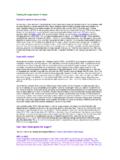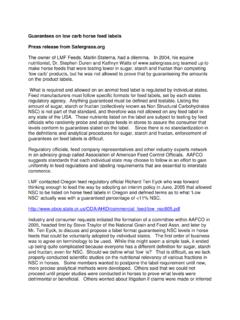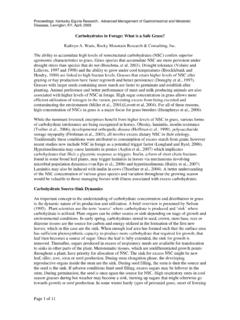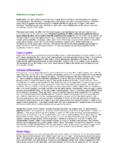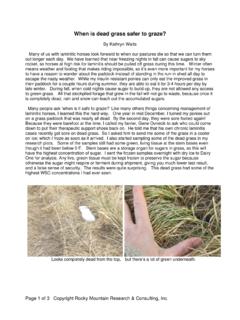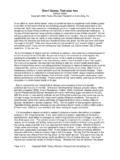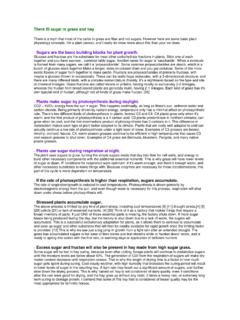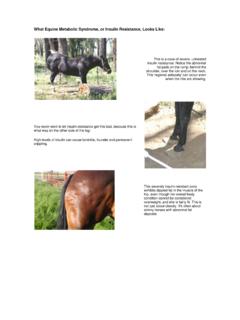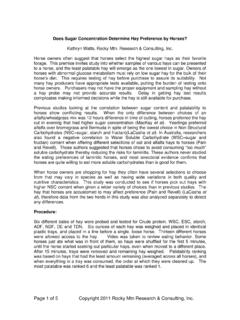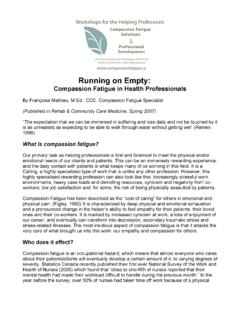Transcription of Laminitis Attack: The First Line of Defense - …
1 Laminitis Attack: The First line of Defense By Dr. Don Walsh, DVM and Kathryn Watts When we discover our horse can barely walk, has hot feet, and shifts its weight onto its hindquarter, air raid sirens go off in our head. We scramble to call our veterinarian and hoof care provider to find the cause and prevent rotation of the coffin bone. Once the cause has been determined, we shift strategy to developing appropriate defensive maneuvers. When the initial attack is over and our horse is starting to walk normally again, tactics shift to rehabilitation and prevention of a relapse. Even the most successful practitioners may fail to offer relief. Far too often, the First attack is so devastating the war is over quickly, and Laminitis has won again.
2 Laminitis can also wage a long, drawn out cold war, engaging in hidden guerilla tactics, undermining our horse s soundness with a slow but relentless onslaught on internal structures. In spite of recent advances in our knowledge about Laminitis , many questions have yet to be answered. When science lags behind the need, miracle cures quickly fill the void. Marketing replaces scientifically conducted clinical trials. If your horse is still in constant pain, after your regular horse care experts have done all they can, you may find yourself searching for a second opinion or alternative therapies. Even the skeptics among us may be tempted to try some scientifically unproven treatment as a last ditch effort.
3 Internet gurus may override the advice of your formerly trusted local veterinarian or hoof care provider. Whom should we trust? How do we tell if our advisor is up to date on new scientific breakthroughs, or operating under old fashioned protocols? How can we navigate the quagmire of conflicting theories and untested products to make better choices for our laminitic horses? Determining Defensive Strategy Laminitis is a symptom with many causes. They include high insulin levels, excessive concussion, excessive weight bearing due to injury on other limbs, carbohydrate overload (binge eating), retained placenta, colic, any systemic illness, bedding with black walnut shavings, ingestion of toxic plants, and excessive use of steroids.
4 The treatment that is most successful for an individual case requires removal of the cause. Once a horse has had more than one attack of Laminitis they are considered chronic and more susceptible. Damaged laminae are more vulnerable to triggers for future episodes. They may experience hoof pain from being overdue for a trim that puts mechanical stress on damaged tissue. Cold weather may make a previously foundered horse sore due to pain from previously damaged nerves or impairment of blood flow. If the coffin bone has descended, the resulting thin soles offer less protection on hard or rocky ground. Once a horse has had Laminitis , there is no going back.
5 Post Laminitis management may be very different for the rest of the horse s life. If you are committed and have the right resources at hand, your horse may recover and have a useful, comfortable life even after a serious bout of Laminitis with significant rotation. Changes in routine are difficult at First for both horse and owner, but they will not seem disruptive once the new plan becomes routine. Page 1 of 8 Team Approach Required The owner, veterinarian and hoofcare provider must work as a team. Finding the best plan often requires an investigative phase, and all team members can provide valuable clues. Direct interaction between the attending veterinarian and hoofcare provider is imperative for successful management of a horse with Laminitis .
6 The resources of the owner in regard to available facilities, finances and time constraints for nursing and rehabilitation are important considerations in determining a viable treatment program. Frequent, ongoing communication should be encouraged by all team members. Experiment, Observe, Adjust Most people do not have the time or background to study every Laminitis treatment out there. We have to rely on experts, but their opinion should not be the end all, be all in the decision process for which a course of treatments to follow. Every case of Laminitis is slightly different. Your horse may respond differently. Your horse s reaction to any treatment should have priority over any expert opinion.
7 If someone says feed him this and the next day he is much worse, question the suitability of the feed or supplement. This is not the time for blind faith. An observant caretaker who knows the animal intimately and sees him several times a day is far more capable of assessing a reaction to treatment. Keep your vet informed, but don t expect him to make every little decision for practical management and nursing. For horses with reoccurring, chronic Laminitis keeping a journal is very useful. Make notes about any changes in diet such as a new batch of hay, bagged feed or new supplement. Make notes on hoof appearance and care, exercise, vaccinations, significant changes in weather, changes in general demeanor.
8 Sometimes a pattern will develop that will allow you to discover a previously unrecognized trigger. Perhaps it s the cold weather that triggers higher sugar levels in your pasture. Or the variable amount of sugar in your bagged feed. Something you may not think is important may have an effect two weeks from now. A journal may help you unravel mysterious causes when a pattern develops over time. This may help you prevent future episodes. When a researcher studies the effect of a variable, it is important to change only one thing at a time to isolate that affect. That s what we call controlled experiments . Control of every aspect that might affect Laminitis is difficult if not impossible, but we have to try when searching for triggers.
9 When our horse gets sore feet in mid-winter, is it a direct effect of cold temperatures on compromised vasculature? Is he due for a trim and the angles of the feet have changed dramatically? Or is it the fact that his exercise has been limited because it s too cold to ride, which has caused an increase in insulin? Or hard, frozen footing? That new batch of hay? The addition or removal of a supplement? Shorter day length effect on hormones? We just can t know which of these factors is most important. Possibly it was the combined effect of all of them. That s where our journal is useful. When multiple factors confound a change in your horse, repeating tests for blood insulin level, and hay analysis may show that you need to focus more on finding a more appropriate diet.
10 Or, you might try the on-off-on-off test. If you consistently see a good affect when you do something, and it goes away if you stop, keeping doing it. Any time you do two new things at once, you cannot know which was most helpful. If your schedule has limited your horse s exercise program, and his cresty neck is getting big and hard, but you also just got a new batch of hay, start soaking the excess sugar out of the hay. If all Page 2 of 8 other factors stay the same, but the lower sugar level is helpful, then you know that that batch of hay is not appropriate. Make notes in your journal to help you determine if it really is helping. Of course if your horse improves with half a dozen different products, a new trimmer, and a different medication source, you may be so relieved you won t want to change a thing.
